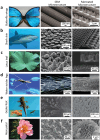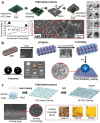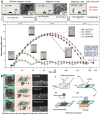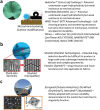Recent Advances in Superhydrophobic Materials Development for Maritime Applications
- PMID: 38403472
- PMCID: PMC11040384
- DOI: 10.1002/advs.202308152
Recent Advances in Superhydrophobic Materials Development for Maritime Applications
Abstract
Underwater superhydrophobic surfaces stand as a promising frontier in materials science, holding immense potential for applications in underwater infrastructure, vehicles, pipelines, robots, and sensors. Despite this potential, widespread commercial adoption of these surfaces faces limitations, primarily rooted in challenges related to material durability and the stability of the air plastron during prolonged submersion. Factors such as pressure, flow, and temperature further complicate the operational viability of underwater superhydrophobic technology. This comprehensive review navigates the evolving landscape of underwater superhydrophobic technology, providing a deep dive into the introduction, advancements, and innovations in design, fabrication, and testing techniques. Recent breakthroughs in nanotechnology, magnetic-responsive coatings, additive manufacturing, and machine learning are highlighted, showcasing the diverse avenues of progress. Notable research endeavors concentrate on enhancing the longevity of plastrons, the fundamental element governing superhydrophobic behavior. The review explores the multifaceted applications of superhydrophobic coatings in the underwater environment, encompassing areas such as drag reduction, anti-biofouling, and corrosion resistance. A critical examination of commercial offerings in the superhydrophobic coating landscape offers a current perspective on available solutions. In conclusion, the review provides valuable insights and forward-looking recommendations to propel the field of underwater superhydrophobicity toward new dimensions of innovation and practical utility.
Keywords: air‐layer; anti‐corrosion; biomimetic; bio‐inspired; robustness; superhydrophobicity, submersible.
© 2024 The Authors. Advanced Science published by Wiley‐VCH GmbH.
Conflict of interest statement
The authors declare no conflict of interest.
Figures













Similar articles
-
A comprehensive review on anticorrosive/antifouling superhydrophobic coatings: Fabrication, assessment, applications, challenges and future perspectives.Adv Colloid Interface Sci. 2024 Feb;324:103090. doi: 10.1016/j.cis.2024.103090. Epub 2024 Jan 21. Adv Colloid Interface Sci. 2024. PMID: 38290251 Review.
-
Self-Driven Gas Spreading on Mesh Surfaces for Regeneration of Underwater Superhydrophobicity.ACS Appl Mater Interfaces. 2024 Jul 31;16(30):40231-40242. doi: 10.1021/acsami.4c07843. Epub 2024 Jul 21. ACS Appl Mater Interfaces. 2024. PMID: 39034615
-
Bio-inspired dewetted surfaces based on SiC/Si interlocked structures for enhanced-underwater stability and regenerative-drag reduction capability.Sci Rep. 2016 Apr 20;6:24653. doi: 10.1038/srep24653. Sci Rep. 2016. PMID: 27095674 Free PMC article.
-
Recoverable underwater superhydrophobicity from a fully wetted state via dynamic air spreading.iScience. 2021 Nov 11;24(12):103427. doi: 10.1016/j.isci.2021.103427. eCollection 2021 Dec 17. iScience. 2021. PMID: 34877492 Free PMC article.
-
Nature-Inspired Superhydrophobic Coating Materials: Drawing Inspiration from Nature for Enhanced Functionality.Micromachines (Basel). 2024 Mar 13;15(3):391. doi: 10.3390/mi15030391. Micromachines (Basel). 2024. PMID: 38542636 Free PMC article. Review.
Cited by
-
Curvature-Enhanced Superomniphobic Property for Minimizing Contact Time of Low-Surface-Tension Liquid.Small Sci. 2025 Mar 4;5(6):2400631. doi: 10.1002/smsc.202400631. eCollection 2025 Jun. Small Sci. 2025. PMID: 40529876 Free PMC article.
-
Dimensional effects of surface morphology and trapped air on mammalian cell adhesion to special wetting surfaces.Regen Biomater. 2025 Apr 1;12:rbaf021. doi: 10.1093/rb/rbaf021. eCollection 2025. Regen Biomater. 2025. PMID: 40270576 Free PMC article.
-
Stable Air Plastron Prolongs Biofluid Repellency of Submerged Superhydrophobic Surfaces.Langmuir. 2025 Jan 28;41(3):1807-1820. doi: 10.1021/acs.langmuir.4c04259. Epub 2025 Jan 15. Langmuir. 2025. PMID: 39813586 Free PMC article.
-
Surface pre-treatment of aluminum alloy for mechanical improvement of adhesive bonding by maple-assisted pulsed laser evaporation technique.RSC Adv. 2024 Jul 18;14(31):22627-22641. doi: 10.1039/d4ra03187c. eCollection 2024 Jul 12. RSC Adv. 2024. PMID: 39027041 Free PMC article.
-
Structurally Defined Amphiphilic AAO Membranes Using UV-Assisted Thiol-Yne Chemistry: Applications in Anti-Counterfeiting and Electronics.ACS Appl Mater Interfaces. 2024 Sep 11;16(36):48073-48084. doi: 10.1021/acsami.4c09040. Epub 2024 Aug 27. ACS Appl Mater Interfaces. 2024. PMID: 39189834 Free PMC article.
References
-
- Brown S., Lengaigne J., Sharifi N., Pugh M., Moreau C., Dolatabadi A., Martinu L., Klemberg‐Sapieha J. E., Surf. Coat. Technol. 2020, 401, 126249.
-
- Manoharan K., Bhattacharya S., J. Manuf. 2019, 2, 59.
-
- Wu Y., Dong L., Shu X., Yang Y., She W., Ran Q., Compos. B. Eng. 2022, 237, 109867.
-
- Gu B.‐E., Huang C.‐Y., Shen T.‐H., Lee Y.‐L., Prog. Org. Coat. 2018, 121, 226.
-
- Yu C., Cao M., Dong Z., Wang J., Li K., Jiang L., Adv. Funct. Mater. 2016, 26, 3236.
Publication types
Grants and funding
LinkOut - more resources
Full Text Sources
